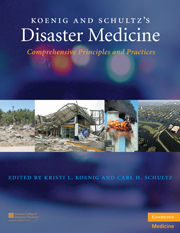Book contents
- Frontmatter
- Contents
- List of Contributors
- Contributor Biographies
- Foreword
- Preface
- Acknowledgments
- PART I CONCEPTUAL FRAMEWORK AND STRATEGIC OVERVIEW
- PART II OPERATIONAL ISSUES
- PART III CLINICAL MANAGEMENT
- SECTION A CBRNE AND HAZMAT
- SECTION B ENVIRONMENTAL EVENTS
- 32 Floods
- 33 Cyclones/Hurricanes/Typhoons
- 34 Tornadoes
- 35 Earthquakes
- 36 Tsunamis
- 37 Winter Storms
- 38 Extreme Heat Events
- 39 Volcanoes
- Index
- Plate section
- References
38 - Extreme Heat Events
from SECTION B - ENVIRONMENTAL EVENTS
Published online by Cambridge University Press: 05 August 2011
- Frontmatter
- Contents
- List of Contributors
- Contributor Biographies
- Foreword
- Preface
- Acknowledgments
- PART I CONCEPTUAL FRAMEWORK AND STRATEGIC OVERVIEW
- PART II OPERATIONAL ISSUES
- PART III CLINICAL MANAGEMENT
- SECTION A CBRNE AND HAZMAT
- SECTION B ENVIRONMENTAL EVENTS
- 32 Floods
- 33 Cyclones/Hurricanes/Typhoons
- 34 Tornadoes
- 35 Earthquakes
- 36 Tsunamis
- 37 Winter Storms
- 38 Extreme Heat Events
- 39 Volcanoes
- Index
- Plate section
- References
Summary
INTRODUCTION
This chapter addresses the medical and public health implications of extreme heat events (EHEs) and the associated mortality and morbidity. EHE conditions can be defined by summertime weather that is substantially hotter and/or more humid than average for a location during a comparable time period. History is filled with the failures of great civilizations caused by significant climate changes reacting with human adaptations. Examples include the collapse of the north African “Bread basket” for ancient Rome, the wind-swept droughts in Oklahoma's “Dust bowl” during the 1930s, the vast European droughts in the Middle Ages, and the severe 1921 drought in extensive areas of the former Soviet Union that resulted in millions of deaths. Even the genocide in the Darfur region of west Sudan has a weather-related component. The ongoing drought has pit herders against farmers, with the added elements of race and religion exacerbating the situation.
There have been more than 20 serious EHEs across the world since 1901, including the deadly 2003 EHE in Europe that killed more than 35,000 people, with 15,000 dead in France alone. In the United States, up to 800 died of EHEs in Chicago and Milwaukee in 1995. Additional thousands have died in Philadelphia, St. Louis, Kansas City, and other major U.S. cities since the early 1990s. EHEs in U.S. mid-Atlantic and midwest cities can be accompanied by glaring sun with no cloud cover, temperatures in the 35°C–40°C range, and heat indexes (temperature and humidity) from 43°C to 51°C or more.
Keywords
- Type
- Chapter
- Information
- Koenig and Schultz's Disaster MedicineComprehensive Principles and Practices, pp. 609 - 631Publisher: Cambridge University PressPrint publication year: 2009
References
- 1
- Cited by



